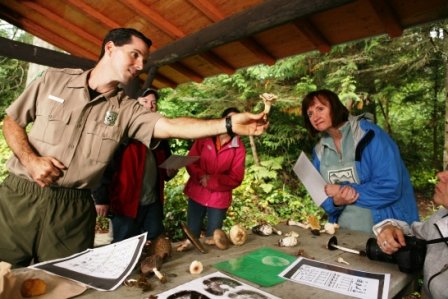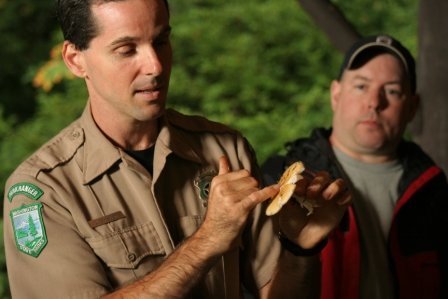 Park Ranger Dan Christian conducts a mushroom identification class at Penrose State Park. Photo by Karina Whitmarsh
Park Ranger Dan Christian conducts a mushroom identification class at Penrose State Park. Photo by Karina Whitmarsh
It’s a typical day at Penrose Point State Park, cool and damp, with an overcast drizzle. Twelve people have gathered under a shelter to learn about how to stalk the wild mushrooms of Washington. Mushrooms are strewn over the picnic table, with others in paper bags. The first thing they learn from Park Ranger Dan Christian, who’s giving this free class, is that there is no easy way to tell if a mushroom is poisonous or not. You need to identify each individual mushroom and get 100% identification before you eat it.
“You need two things: patience and observation,” Christian said, adding that it can take a few days or longer to properly identify mushrooms. In addition, you’ll need to become familiar with terms like gills, cap, veil, volva, deliquescent, decurrent, bulbous, ring, and a few others. Knowing the parts of the mushroom and what variables to look for are critical to correctly identifying the fungus. This, of course, means the difference between a delicious omelet, and poisoning or death, as the KP is home to both edible and poisonous varieties. You’ll need to hone your observation skills, using all of your senses except hearing to search for clues. Some smell like fish, or shrimp, or, as the author of one mushroom book has put it, like ‘a cross between red hots and dirty socks’.” Christian gets a laugh from the class on that one, adding, “What a joy to have some new smell in your life.”
 First lesson, there is no easy way to tell if a mushroom is poisonous. Photo by Karina Whitmarsh
First lesson, there is no easy way to tell if a mushroom is poisonous. Photo by Karina Whitmarsh
There are a few essential rules. First, over time, search for the mushroom in all of its development stages, from baby to adult to rotting, because each yields different clues. Second, always collect the entire specimen, including the tissue below ground, because it contains more clues. The mushroom is just the reproductive, fruiting body of a much larger fungal organism that lives underground. Think of an apple to a tree. Third, take notes in the field to capture information such as color changes, bruising patterns, and the color of “latex,” which is a fluid that leaks from many mushrooms. This fluid will be different colors, and the colors may or may not change. Lastly, you’ll want to get a spore print, which is obtained by placing the cap over a piece of paper from several hours to overnight. Spores drop from the cap and make a black or white pattern, critical to proper identification. You’ll also need a good mushroom book that not only has photographs, but also identification “keys” which will walk you through “if/then” steps to help you identify specimens.
If you’re serious about collecting, the best and safest way to start is to take a class, like Ranger Christian’s two-hour class. If you’re willing to put the time in, you can be rewarded with some great new tastes of local favorites like chanterelles, oyster mushrooms, and hedgehog mushrooms among others. Just take his advice, and make sure you eat your own mushrooms and not someone else’s. They may not have been to the class.
UNDERWRITTEN BY THE FUND FOR NONPROFIT NEWS (NEWSMATCH) AT THE MIAMI FOUNDATION, THE ANGEL GUILD, ADVERTISERS, DONORS AND PEOPLE WHO SUPPORT INDEPENDENT, NONPROFIT LOCAL NEWS